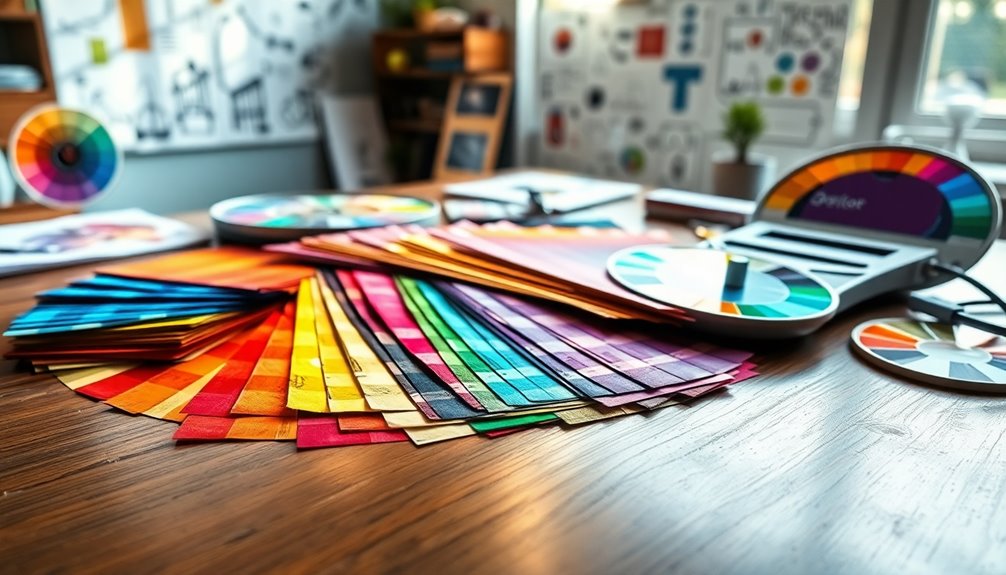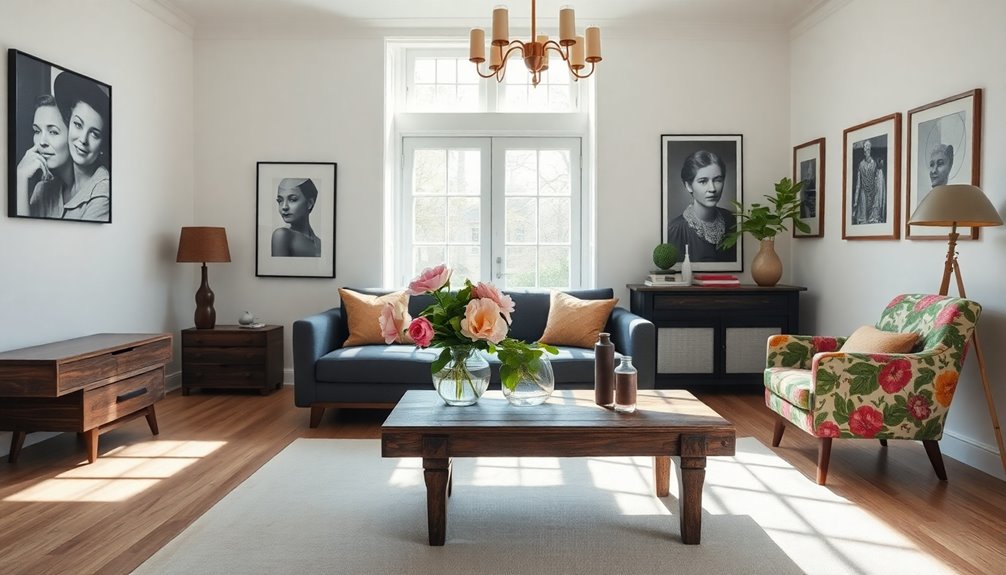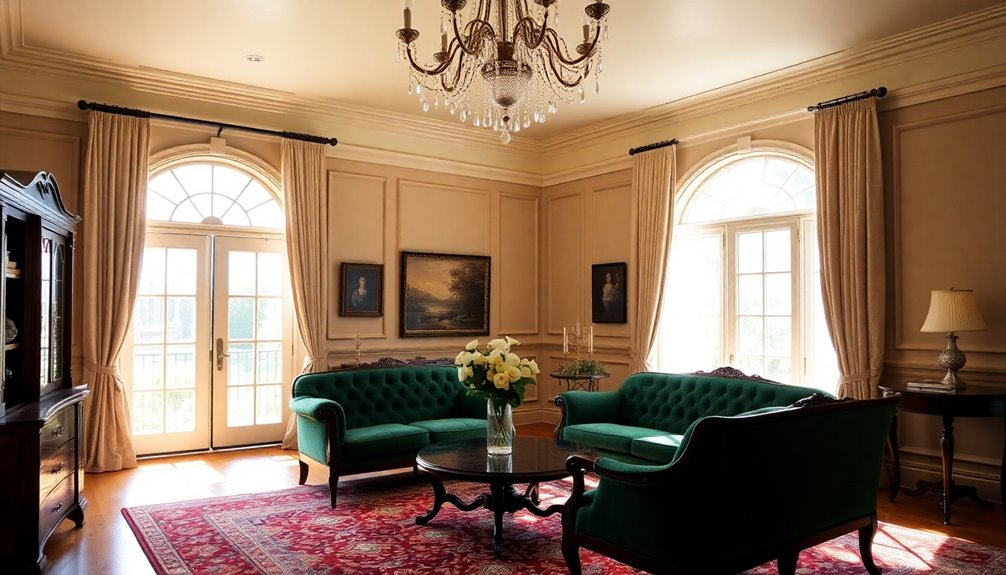Color choice isn’t just about aesthetics; it’s vital for evoking emotions and shaping brand identity. When you select colors wisely, you can inspire trust, excitement, or calmness. Did you know that 85% of consumer decisions hinge on color? Plus, consistent color palettes can boost brand recall markedly. It’s also essential for readability; poor contrast can frustrate users. Effective color combinations guide attention where it matters most in your design. By mastering color harmony and using the right tools, you can elevate your work. If you’re curious about practical applications and techniques, there’s plenty more to explore! Choosing the perfect color scheme involves understanding the psychology behind different colors and their impact on human emotions. For example, warm colors like red and orange can create a sense of urgency or excitement, while cool colors like blue and green can evoke a feeling of relaxation or trust. By carefully selecting the right combination of colors, you can effectively communicate your brand’s message and create a memorable visual identity that resonates with your target audience. Experimenting with various color palettes and getting feedback can also help you fine-tune your choices and create a powerful visual impact.
Key Takeaways
- Color influences emotions; strategic choices can evoke desired feelings and enhance viewer engagement in design.
- Consistent color palettes improve brand recognition and recall, significantly impacting consumer loyalty and trust.
- High contrast in color combinations ensures readability, making designs accessible to diverse audiences, including those with color vision deficiencies.
- Effective use of color harmony creates visual appeal and guides user attention, enhancing interaction rates and overall user experience.
- Tools for color selection and evaluation help maintain brand consistency and adapt to emerging trends, ensuring relevance in design.
Emotional Impact of Color

Understanding the emotional impact of color is vital for effective design. Every color you choose can evoke specific feelings and influence how viewers respond to your work. For instance, blue is often linked to trust and calmness, making it an appropriate color for designs that aim to instill confidence. In contrast, red signifies urgency and excitement, which can create a sense of immediacy in your messaging.
Warm colors like red, yellow, and orange generate energy, while cool colors such as blue, green, and purple promote relaxation. By leveraging these associations, you can shape the emotional atmosphere of your designs. Yellow, for example, is tied to optimism and happiness, effectively uplifting your brand messaging and enhancing viewer engagement.
Cultural interpretations of colors also play a significant role. What resonates positively with one audience may not have the same effect on another. By understanding your target demographic, you can select the appropriate color that not only aligns with their values but also elicits the desired emotional response.
Since research shows that up to 85% of consumers make purchase decisions based on color, your choices can greatly impact emotional impact and brand perception.
Color and Brand Identity

When you think about your brand, the colors you choose play a huge role in how people recognize and connect with it.
Colors evoke emotions, and using them strategically can make your brand stand out and resonate with consumers. Understanding small mistakes in color selection can help avoid miscommunication and enhance your brand identity.
Color's Impact on Recognition
Color plays a significant role in brand recognition, with studies showing that consistent use of a specific color palette can boost brand recall by up to 80%. When you choose your color palettes wisely, you're not just picking colors; you're shaping your brand identity.
Different colors convey different values—blue often symbolizes trust and dependability, while red evokes excitement and urgency. This direct impact on consumer perceptions makes color choice essential for your brand. Additionally, understanding how dog training techniques can influence behavior is similar to how color can shape consumer reactions. The principles of the Law of Attraction can also mirror the importance of emotional alignment in branding. Interestingly, studies show that color can even influence mood enhancement, further emphasizing its power in branding.
In fact, approximately 90% of snap judgments about products can be attributed to color alone. If you want your audience to recognize and remember your brand, focusing on a cohesive color palette is imperative.
Companies that effectively use color in their branding enhance customer loyalty and recall, as consistent color use fosters familiarity and trust. Research also indicates that 85% of consumers make purchases based on color, highlighting how significant color choice is in establishing a memorable and impactful brand identity. Moreover, as AI algorithms expected to personalize online shopping experiences continue to develop, the role of color in influencing consumer behavior will likely become even more pronounced.
If you want your brand to stand out and resonate with your audience, prioritizing your color strategy is key. Your color choices aren't just aesthetic; they're crucial for recognition and connection.
Emotional Connection With Colors
The emotional connection you create through color can greatly enhance your brand identity. Each color evokes specific feelings—blue often conveys trust and reliability, while red signifies excitement and urgency. Understanding the meaning of colors is crucial for resonating with your target audience's preferences and values.
When you choose colors thoughtfully, you're not just picking a palette; you're crafting a message that speaks to your consumers' emotions.
Consistency is key. By maintaining a coherent color palette across your branding, you strengthen recognition and recall, boosting brand awareness by up to 80%.
However, remember that cultural associations can vary widely. For instance, while white symbolizes purity in Western cultures, it may represent mourning in certain Eastern societies. Being aware of these nuances guarantees your brand resonates positively across different demographics.
Ultimately, effective color selection doesn't just enhance aesthetic appeal; it fosters deep emotional connections with consumers. This connection can lead to increased brand loyalty and engagement, making color choice a crucial component of your overall branding strategy. Additionally, incorporating the psychology of color into your branding can provide insights into consumer behavior and preferences.
Enhancing Readability and Accessibility

Often, high color contrast between text and background is vital for enhancing readability and accessibility. To guarantee your designs are user-friendly, aim for a contrast ratio of at least 4.5:1 for normal text and 3:1 for large text. This helps users with visual impairments easily read your content.
Utilizing colorblind-friendly palettes can further improve user experience, considering that around 8% of men and 0.5% of women experience some form of color vision deficiency. Following established accessibility guidelines, like the Web Content Accessibility Guidelines (WCAG), guarantees that your color choices don't alienate these users.
Testing your designs with diverse audiences is essential. Engage individuals with various visual abilities to identify potential readability issues. This fosters inclusivity and helps you create designs that cater to everyone.
Make use of tools like contrast checkers and color accessibility analyzers to evaluate your color combinations. These resources will assist you in confirming that your designs meet established accessibility standards, allowing you to create visually appealing and inclusive materials.
Visual Hierarchy in Design

Effective visual hierarchy in design helps you guide users' attention to the most important elements on your page. By arranging elements strategically, you can lead users' eyes through your content, making it easier for them to process information.
Utilizing complementary colors can greatly enhance this effect. Here are key strategies to establish a strong visual hierarchy:
- Size: Use larger elements for primary actions, like call-to-action buttons, to draw attention.
- Color: Assign bold colors to important elements and muted tones to secondary information, creating contrast.
- Spacing: Increase space around critical items to make them stand out and improve focus.
- Layout: Organize content logically, ensuring that users can navigate intuitively. Audience engagement strategies are also essential in maintaining user interest.
When you implement these principles of visual hierarchy consistently, you not only improve user interaction rates but also enhance overall design balance. Understanding pricing models is also crucial for ensuring that the visual appeal aligns with client expectations.
Users will appreciate a layout that guides them seamlessly, allowing them to find what they need without confusion.
Mood and Atmosphere Creation

Color plays an essential role in shaping the mood and atmosphere of your design. By understanding color psychology, you can evoke specific emotional responses from your audience.
For instance, warm colors like red, yellow, and orange generate energy and warmth, making them great for designs aiming to inspire excitement and action. On the other hand, cool colors such as blue, green, and purple promote calmness and tranquility, creating peaceful atmospheres perfect for relaxation and focus. Additionally, incorporating scents such as eucalyptus oil can enhance feelings of relaxation and clarity, complementing the calming effect of cool colors. Furthermore, the use of aromatic cleaning methods can help maintain a fresh environment that supports the intended mood of your design. The right choice of colors can also elevate the presentation of your work, similar to how float mounting textile art enhances the visual impact of textile pieces.
The combination of colors can also greatly shift the overall mood of your design. Pairing warm and cool colors can create dynamic tension and visual interest that keeps viewers engaged.
Seasonal colors—like autumnal oranges and browns or spring pastels—can align your designs with specific marketing campaigns, enhancing emotional resonance with your audience.
Ultimately, the right color choices not only enhance your visual aesthetic but also influence viewer behavior and perception. By strategically selecting colors, you can craft an atmosphere that resonates deeply with your audience, drawing them into your design and impacting their overall experience. Additionally, incorporating certain scents through essential oils for aromatherapy can further enhance the emotional atmosphere you aim to create.
Cultural Significance of Colors

Understanding the cultural significance of colors is vital for any designer aiming to create impactful work. Color meanings can differ dramatically around the globe, and recognizing these variations helps you connect with your audience more effectively.
For example:
- White: Purity and weddings in Western cultures; mourning in many Eastern cultures.
- Red: Luck and prosperity in China; mourning in South Africa.
- Blue: Trust and reliability in many cultures; sadness or mourning in some Middle Eastern cultures.
- Green: Nature and life in numerous cultures; jealousy or inexperience in specific contexts.
With globalization, some color meanings have become more standardized, but local interpretations still reign.
As a designer, you need to be culturally sensitive. Failing to take into account these nuances can lead to miscommunication or offense.
Always research the cultural significance of colors relevant to your design projects to guarantee your choices resonate positively. By doing so, you not only enhance your designs but also show respect for diverse cultural perspectives, making your work truly impactful.
Tools for Color Selection

When you're selecting colors for your design, online palette generators like Adobe Color and Coolors can be your best friends, helping you create cohesive schemes.
Additionally, color contrast checkers guarantee that your choices aren't only visually appealing but also accessible to all users.
Using these tools effectively can elevate your design and enhance user experience.
Online Palette Generators
A variety of online palette generators can simplify the process of selecting colors for your design projects. Tools like Adobe Color and Coolors enable you to explore various color combinations by generating complementary, analogous, or triadic schemes based on a base color. This makes creating a color palette not only easier but also more enjoyable.
Here are some key features of these generators:
- Collaboration: Save and share your palettes to guarantee consistent branding across projects.
- Accessibility: Many include built-in accessibility checkers, confirming your color combinations meet recommended contrast ratios.
- Trends: Explore user preferences and trending color combinations to stay current with popular styles.
- Export Options: Easily export palettes in formats like HEX, RGB, and CMYK for compatibility with various design software.
Using online palette generators can enhance your design process, making it straightforward to create stunning visuals. By leveraging these tools, you can confidently choose colors that resonate with your audience while guaranteeing an inclusive experience for all users.
Color Contrast Checkers
In today's design landscape, ensuring your color choices meet accessibility standards is essential. One of the best ways to do this is by using color contrast checkers. These are invaluable tools that evaluate the contrast ratio between your foreground and background colors, helping you comply with accessibility guidelines for readability.
When you use a color contrast checker, you'll receive a numerical value representing the contrast ratio. For normal text, aim for a minimum ratio of 4.5:1, and for large text, a ratio of at least 3:1. This will greatly enhance usability for visually impaired users. Tools like WebAIM and Accessible Colors allow you to input hex codes and quickly check if your color combinations meet these standards.
Some advanced contrast checkers even simulate how colors appear to individuals with color blindness, guiding you in creating inclusive color palettes.
By incorporating color contrast checkers into your design process, you can reduce the risk of poor visual accessibility, ultimately leading to better user experiences and increased engagement.
Prioritizing accessibility not only helps your audience but also elevates your overall design quality.
Color Psychology in Marketing

Color psychology in marketing noticeably influences how consumers perceive products and make purchasing decisions. Research shows that a staggering 90% of snap judgments about products are based on color alone. This means you need to carefully consider your color schemes to effectively communicate your brand's message.
Different colors evoke specific emotional responses. For example, blue conveys trust and reliability, making it ideal for financial and tech brands. On the other hand, warm colors like red and orange create a sense of urgency, often boosting sales during promotions.
Here are some key points to remember about color psychology in marketing:
- Brand Recognition: Consistent color schemes can increase brand recognition by up to 80%.
- Cultural Context: Colors have different meanings across cultures; white signifies purity in the West but mourning in the East.
- Emotional Triggers: Each color can elicit different emotions, impacting consumer behavior.
- Urgency and Action: Warm colors can prompt quicker purchasing decisions.
Color Trends and Innovations

Understanding color psychology lays the groundwork for exploring the latest trends and innovations in design. Today, color trends often mirror cultural shifts and societal values. With an increasing emphasis on sustainability, earthy tones and greens are gaining popularity in various design fields. Many families are now drawn to destinations with water parks that reflect these color trends, enhancing their overall vacation experience. The tea industry's focus on sustainable production practices also influences consumer preferences for eco-friendly design choices. Notably, water parks often feature bright color schemes to create a vibrant atmosphere that attracts visitors.
Innovations in color technology, like Pantone's Color of the Year, help guide your color choices, ensuring they resonate with current consumer sentiments.
The rise of digital media has also transformed how brands use color. Vibrant, bold colors dominate online branding, capturing attention in crowded digital spaces and making your designs stand out. Water parks often utilize bright, engaging color schemes to create an inviting atmosphere for guests.
Additionally, color forecasting agencies analyze consumer behavior to predict emerging color trends, allowing you to align your designs with anticipated market shifts.
One exciting trend is the incorporation of unexpected color combinations, such as pairing pastels with neon hues. This approach promotes creativity and encourages breaking traditional color rules, making your designs more dynamic and engaging. Furthermore, understanding city dynamics can also play a role in how color choices resonate within specific urban environments.
Practical Tips for Color Application

When you're applying color in your designs, focus on achieving harmony and ensuring readability.
Use techniques like complementary color schemes to create appealing visuals, while also prioritizing contrast to make your text easy to read.
Color Harmony Techniques
In the domain of design, mastering color harmony is essential for creating visually appealing compositions. To achieve this, you can utilize various techniques that enhance the overall aesthetic of your work.
Start by exploring complementary colors—those opposite each other on the color wheel. They create striking visual contrasts that grab attention.
You might also want to experiment with the following techniques:
- Analogous color schemes: Use three adjacent colors for a cohesive and harmonious look.
- Triadic color schemes: Choose three evenly spaced colors to add vibrancy while maintaining balance.
- Limit your palette: Stick to three to five colors to guarantee simplicity and focus.
Finally, test your color combinations using tools like Adobe Color or accessible-colors.com. These resources help confirm readability and accessibility across different mediums.
Contrast for Readability
Often, high color contrast between text and background makes a notable difference in readability. To guarantee accessibility, aim for contrast ratios of at least 4.5:1 for normal text and 3:1 for large text. Using dark text on a light background or light text on a dark background not only reduces eye strain but also enhances comprehension during prolonged reading.
You should also be wary of colors that are too similar in hue, as they can create visual confusion. Instead, incorporate complementary colors to provide clearer differentiation. Testing your color combinations is essential; tools like accessible-colors.com can help you evaluate whether your choices maintain contrast for readability, especially for users with visual impairments.
Additionally, consider colorblind-friendly palettes. Using patterns or textures along with color can greatly improve usability for individuals with color vision deficiencies.
Frequently Asked Questions
Why Is Color so Important in Design?
Color's essential in design because it shapes emotions and perceptions. When you choose the right colors, you create a mood that resonates with your audience.
Colors can enhance readability, making your content accessible to everyone. They guide viewers' attention and establish a visual hierarchy, ensuring key information stands out.
Plus, a well-thought-out color palette fosters brand recognition, helping your brand stick in people's minds.
Ultimately, color's impact can't be overlooked in any design project.
Why Is Color Choice Important?
Color choice is important because it shapes how people perceive your design and influences their emotions.
When you select the right colors, you can create energy or calmness, guiding the viewer's experience. It also enhances readability and accessibility, ensuring everyone can engage with your content.
Plus, a coherent color palette boosts brand recognition and loyalty.
Ultimately, understanding color's impact helps you communicate effectively and connect with your audience on a deeper level.
Why Is Color the Most Effective Element of Design?
Color's the most effective element of design because it directly impacts emotions and actions. When you choose the right colors, you can evoke feelings, guide attention, and create a strong visual hierarchy.
Colors help your audience connect with your message, making them more likely to engage and convert. By understanding how different colors influence perception, you can craft designs that resonate with your audience and effectively communicate your brand's identity.
Why Is Color Important in Character Design?
Color's essential in character design because it shapes how you perceive a character's personality and emotions.
When you choose vibrant hues, you evoke positive feelings, while darker shades can create a sense of mystery. A coherent color palette not only helps audiences remember characters but also guides their attention to important features.
Plus, considering cultural meanings guarantees your design resonates with diverse viewers, making your character relatable and engaging.








